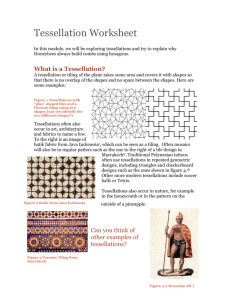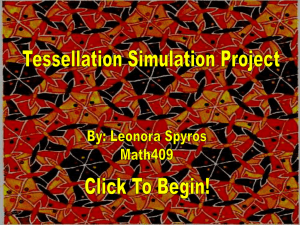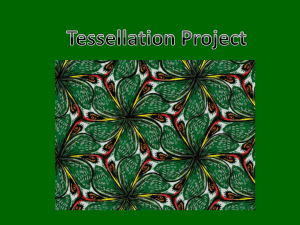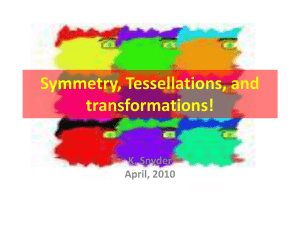Grade 7/8 Math Circles M.C. Escher and Tessellations Tiling the Plane
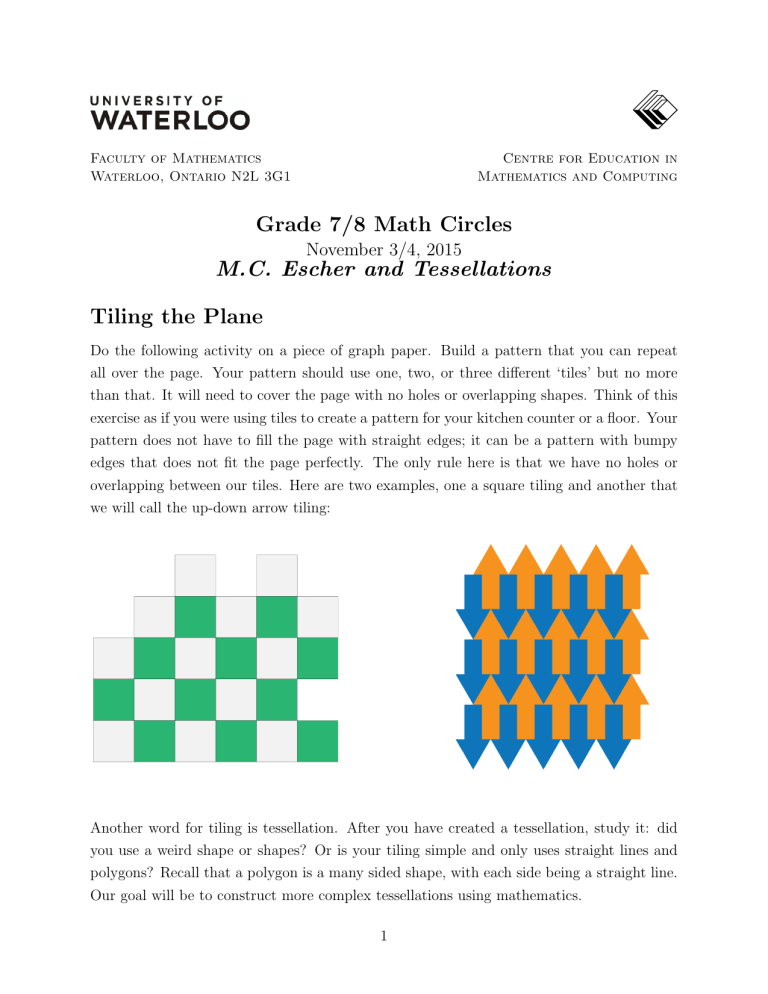
Faculty of Mathematics
Waterloo, Ontario N2L 3G1
Centre for Education in
Mathematics and Computing
Grade 7/8 Math Circles
November 3/4, 2015
M.C. Escher and Tessellations
Tiling the Plane
Do the following activity on a piece of graph paper. Build a pattern that you can repeat all over the page. Your pattern should use one, two, or three different ‘tiles’ but no more than that. It will need to cover the page with no holes or overlapping shapes. Think of this exercise as if you were using tiles to create a pattern for your kitchen counter or a floor. Your pattern does not have to fill the page with straight edges; it can be a pattern with bumpy edges that does not fit the page perfectly. The only rule here is that we have no holes or overlapping between our tiles. Here are two examples, one a square tiling and another that we will call the up-down arrow tiling:
Another word for tiling is tessellation. After you have created a tessellation, study it: did you use a weird shape or shapes? Or is your tiling simple and only uses straight lines and polygons? Recall that a polygon is a many sided shape, with each side being a straight line.
Our goal will be to construct more complex tessellations using mathematics.
1
Review of Different Symmetries
Recall how reflections and rotations operate. Reflections require a line about which we flip a shape. Rotations are always around a point. The diagrams above illustrate examples of a line of reflection and a point of rotation for a triangle. DO NOT perform reflections or rotations without first identifying a line of reflection or a point of rotation.
The three symmetries below we will not describe in as much detail as reflections and rotations.
Translations simply move the shape around the plane. Glide reflections are a combination of reflection and translation with the key difference being that the translation has to be along the line of reflection. Scaling can produce similar shapes that are either larger or smaller.
Using Symmetry as Instructions
Symmetry gives us words we can use to describe how a shape can change from one position to another. On the next page, use symmetry (translations, reflections, rotations, glide reflections, and scaling) to describe the changes from black to grey in each shape.
2
Answers may vary. Here are some solutions.
1. Translate 7 units right. Rotate about bottom left corner 90 degrees counter-clockwise.
2. Rotate 135 degrees counter-clockwise.
3. Scale to twice the height and width. Translate 4 units to the right.
4. Reflect across a horizontal line exactly 1.5 units up from the bottom of the grid.
Translate 4 units to the right.
5. Reflect across the bottom right side of the hexagon (the side that touches the new hexagon).
6. Rotate 90 degrees clockwise about the bottom left bulge of the shape. Reflect across a vertical line from the top of the shape to the bottom (just flips the shape in place).
Translate 1 unit right and 3 units up.
7. Reflect across the line (not a grid line, but half-way between grid lines) that is exactly half-way between the bases of the sevens.
Describing Tessellations
We can use symmetry to create more complicated tessellations. First, we need to be able to identify the symmetries in tessellations. Recall the up-down arrow tiling; use symmetry to
3
write instructions so someone else could create this tiling. When you write your instructions, you do not need to explain the colouring of the shapes. Colouring does not change the shapes in a tessellation.
Exercise: Use symmetry to give some instructions on how to make these tessellations.
When you write your instructions, try to determine a ‘tile’ that you can repeat using symmetry.
This may make your description a lot clearer.
For example, I could describe the up-down arrow tiling as one up arrow and one down arrow fit together as a tile and this shape is translated to make the tessellation.
You may use the following symmetry to construct each tessellation:
1. Translation, reflection, rotation, glide reflection. No scaling.
2. Translation, rotation, glide reflection. No reflection, no scaling.
3. Reflection and translation.
4. Scaling, reflection.
5. Translation, reflection, glide reflection.
Escher Tessellations
Maurits Cornelis (M. C.) Escher was a Dutch artist who could create amazing works of art.
Often this art was mathematical in nature, such as his famous woodcut Metamorphosis II below. Escher often used regular tessellations (triangles, squares, hexagons) as a basis to create fancier tiles. He called each of his creations a “Regular Division of the Plane”.
4
Figure 1: Escher, M.C.
Metamorphosis II . 1940. Gallery: Selected Works by M.C. Escher.
www.mcescher.com
. Woodcut. September 29, 2015.
To construct some of his tessellations, Escher chose a regular polygon tiling and subtracted pieces from its area and then added them to other sides. What side he chose depended on the symmetry he wanted to recreate.
Here is a beetle tessellation I created earlier. I chose a beetle because I could imagine its pincers connecting nicely with its abdomen. I chose a square tiling because its symmetry is fairly simple. Since creating the pincers would also create the back end of the beetle, I knew I needed to use translation to make my tessellation to ensure that each beetle’s pincers fit into the backside of the other. In a square tessellation, only the right side touches the left and only the top touches the bottom. The same must be true for my beetle. Therefore, anything I subtracted from the left needed to be added to the right, or vice versa. Similarly, pieces from the bottom should be moved to the top, or vice versa.
I then needed to draw the legs and that took a bit of playing around to design but eventually
I settled on the square you see at the top. Using your imagination you can see the pincers and the legs. The arrows tell us the direction in which I move the pieces. For this square,
I only cut from the bottom or top and moved to the other side, there are no left and right cuts. The second picture is a quick test to see how the beetle looks before I add more detail, as in the third picture.
5
In the third picture and in the one on the left, I have added detail to make the beetle more realistic. One should be very careful bending the straight lines in our original tessellation because it may be that our finished creation does not fit together afterwords! I used symmetry to accomplish this task as well.
The only pieces that could affect how the beetles fit together are perimeter lines of the square. Adding detail on the interior requires some artistry.
Fortunately, since I cut pieces only from the top and bottom perimeter, I do not need to worry about the top or bottom having poor connections (since they do not touch another beetle). So the left and right perimeter that make up the hind legs are what concern us.
Since we are using translations, I am required to draw exactly the same line on the left side of the square as the right. This ensured that any pimples on that line would be dimples on the right line. Here is an illustration of the simple rule I developed to make perfect fits.
Exercise: Think about how the lines would change if I wanted rotational or reflective symmetry on a square. Does this identical line rule always work?
This identical line rule will always work for translation, reflection, and rotation, however, some extra rules may need to be added. For example, if a vertical reflection is used and then the shape is translated downward, the identical line rule will fall apart unless we make each half of the line identical and opposite.
Any of the lines that are inside the square, I can simplify my identical lines rule by just changing the line before I cut out the pieces. This way, my cut will produce two lines that fit together perfectly.
6
To start your own Escher tessellation, pick a simple tessellation as a base and find a ‘tile’ in it that you can repeat easily to fill a page. In the example above, I chose a hexagon and two triangles because they stack together nicely and fit side-by-side. Then I repeated this tiling into a 3 × 3 tessellation so that I could look at the middle piece and bend its lines according to my symmetry and identical line rule. If you look at the image on the left, every piece that protrudes from the original shape is a piece that can fit inside the original shape as well, in a different spot. For example, the ‘legs’ are cut from the top corners of the original shape.
Exercise: (Practice makes perfect!) Make your own Escher Tessellation. I recommend starting with either a square or triangle tessellation and choosing either translative or rotational symmetry. If you get a handle on those and want to create more, try other tessellations and other symmetries. YouTube is a great resource for more instruction.
Here are three more of Escher’s regular divisions of the plane. He drew the first two using square tilings and the last using a triangular tiling.
Figure 2: From left to right: Escher, M.C.
Crab (1941), Winged Lion (1945), Bird (1941).
Gallery: Selected Works by M.C. Escher.
www.mcescher.com
. Pencil, Ink, Watercolour.
September 30, 2015.
7
Exercises
1. Here is a question from the 2006 Grade 7 Gauss contest:
The letter P is written in a 2 × 2 grid of squares as shown:
A combination of rotations about the centre of the grid and reflections in the two lines through the centre achieves the result: and reflections is applied to
. When the same combination of rotations
, the result is which of the following:
Solution: (b)
2. Take the letters in your first name and perform the following symmetrical operations on them: reflect each letter through a horizontal line, and then rotate each letter 180
◦
.
Which letters in your name look different and which look the same? Explain why some letters look the same.
3. For each of the following tessellations, find a ‘tile’ that can be repeated using symmetry to construct the whole tessellation with no gaps. Note: a tile does not have to be one shape and for most tessellations it will be several shapes. It needs to fit together with itself to produce the entire tessellation. Remember that a tessellation can go on forever in any direction on a flat surface.
8
(a) Pick any two triangles that share an edge, this will serve as our tile. We can repeat this tile by translation until the tessellation is as large as we want. (b) Select a hexagon with two triangles, one rightside up, the other upside down as our tile. It can be repeated by translation. (c) Pick a any octagon and a square that share a side as our tile; repeat with translation. (d) Pick a square and two triangles. The square shares an edge with one triangle, that triangle shares one edge with another triangle. Repeat using reflections and rotations. (c) Pick the same tile as (b) but with two additional squares, one sharing an edge with the hexagon, the other with a triangle. (f) Pick two dodecagons and two triangles, fit the triangles between the two dodecagons. Repeat using translation.
4. A King and Queen have four children who will eventually inherit their lands. They want to split up their land into equal portions so that their children will not go to war with one another. Find a single unbroken shape that will tessellate their land perfectly into four territories. Two copies of their land are pictured below and one for practice, one for your solution.
5. A vertex is single point at the corners of polygons. We can describe tessellations made from regular polygons by how many fit around at least one vertex. Here are three examples with a emphasized vertex in white:
9
(a) How would you describe the three tessellations above using the vertex?
Two octagons, one square about a vertex. Two dodecagons, one triangle about a vertex. Two triangles, two hexagons about a vertex.
(b) We can label the tessellations as follows; what do the numbers in the labels mean?
4 .
8 2 3 .
12 2 (3 .
6) 2
Each number stands for a shape with that many sides. The exponent tells us how many of each number (shape with that number of sides) we have. The period separates shapes. The brackets in the rightmost tessellation indicate we have two of both of the shapes in the order 3.6, since the exponent is outside of the brackets.
6. * An Archimedean tessellation is a tessellation containing only regular polygons. These tessellations are nice because we can count how many there are under certain conditions. In the previous question, you learned what a vertex is for tessellations and that we can label tessellations using the number of shapes that fit around a single vertex.
A single vertex is limited to 360 degrees of space for interior angles of polygons. For example, three regular hexagons fit around a vertex because each has an interior angle of 120
◦ and 120 + 120 + 120 = 360. Remember, we do not have to only pick one shape to put around our vertex, we can have multiple shapes. Your job now is to find all of the different shapes that fit together around a vertex.
Hints: Use interior angles to find combinations that sum to 360. Here is a formula for the interior angle of a regular polygon with n sides: 180 − combinations of shapes that add to 360
◦
360
. There are 21 possible n but not all of these can be used to make tessellations. To make our lives easier, you should only find the 15 combinations that use triangles, squares, hexagons, octagons, and dodecagons (12 sides).
Here are the 15 combinations using the notation of the previous question:
7.
3 6 4 4
3 4 .
6 (3 .
6) 2
4 .
6 .
12 3 2 .
6 2
3 .
6 3
12 2
3
4
3
.
.
4
8 2
2 3 2 .
4 .
3 .
3 .
4 .
6 .
4
4
3 .
4 2 .
6 3 2 .
4 .
12 3 .
4 .
3 .
12
Dual tessellations are drawn by identifying the centre of each shape in a tessellation and then connecting by lines the centres of shapes that share an edge with each other. For example, on left is a square tessellation (in black) and its dual which is again a square tessellation.
Tessellations will not always have themselves as a dual. Draw the dual tessellations on top of the following three Archimedean tessellations:
10
11


